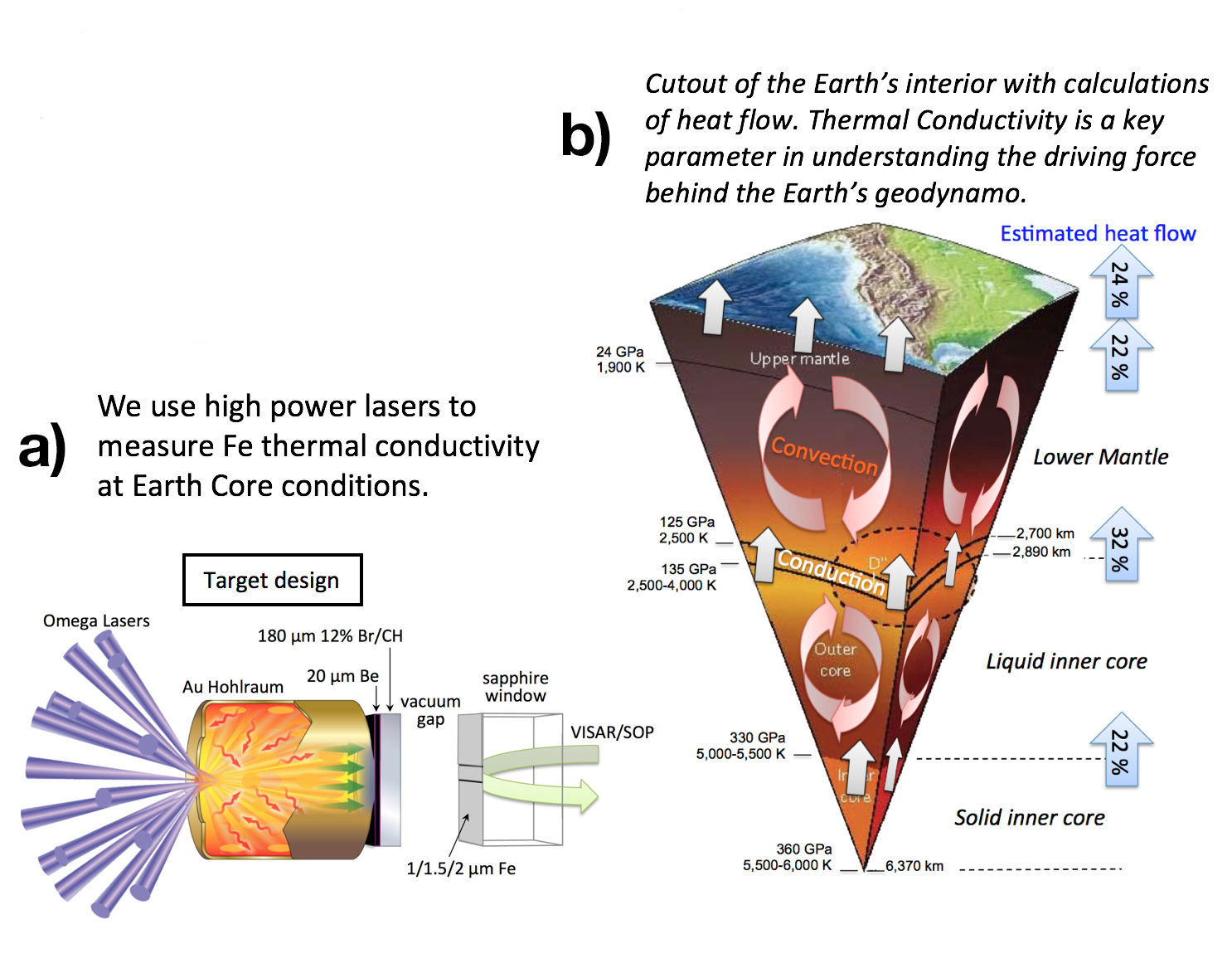Jon Eggert (17-ERD-075)
Executive Summary
We are measuring the thermal conductivity of dynamically compressed materials to gain an accurate measurement of this property, which has direct relevance for the Earth’s mantle and core temperature, magnetic field, and interior evolution. It also plays a limiting role in supercooled solidification kinetics and morphology and is important for Inertial Confinement Fusion modeling efforts.
Project Description
Thermal conductivity is one of the most important and yet most difficult to measure physical property of materials. Within the Earth’s interior, the thermal conductivity of iron and iron-rich alloys at core pressure and temperature conditions is a key parameter for heat-transport models and plays an important role in determining the temperature profile and energy balance of our planet. The standard model of how the Earth’s magnetic field (geodynamo) is powered is based upon an understanding of the thermal conductivity of iron and iron-rich alloys at Earth-core pressure and temperature conditions and the conductive heat flow across the core–mantle boundary. However, recent upward revisions of the thermal conductivity for the outer liquid core based on density function theory calculations and extrapolations of low-pressure electrical resistance measurements have called into doubt this standard model of heat flow within the Earth. This has raised many questions as to the source of kinetic energy needed to drive the geodynamo. We are measuring the thermal conductivity of dynamically compressed materials. An accurate measurement of this property has direct relevance for the Earth’s accretion and differentiation, mantle and core temperature, magnetic field, and interior evolution. We intend to measure the thermal conductivity of iron at Earth core conditions using the “plasma-piston” ramp-compression technique developed in recent years on Livermore’s Janus laser and the Laboratory for Laser Energetics OMEGA laser. Iron samples will be ramp compressed and held at pressures between 50 to 350 GPa. Simultaneously, the plasma-piston drive will launch a time-varying thermal wave through the compressed material. Using the OMEGA streaked optical pyrometer diagnostic, the transit time of the heat wave through multiple iron thicknesses will help constrain the thermal conductivity within the Earth’s core.
Thermal conductivity is of great importance to the geoscience community because it plays a key role in planetary models and has direct implications to our understanding of how the Earth’s magnetic field is powered. Experimentally, thermal conductivity of the Earth’s core remains poorly constrained because of the extreme difficulty in making thermal transport measurements under the relevant pressure and temperature conditions. Thermal conductivity is also relevant to Lawrence Livermore’s mission in that thermal transport plays a limiting role in supercooled solidification kinetics and morphology, and is a key property in Inertial Confinement Fusion modeling efforts. Thermal conductivity is a rate-limiting parameter for crystallization under rapid compression. We expect to measure the thermal conductivity of iron at Earth core conditions using plasma-piston ramp-compression techniques that have been developed in recent years on the Janus and OMEGA lasers. Ramp compression produces less dissipative heating, thus enabling higher compression and lower temperature than shock compression. Ramp-compression equation-of-state and x-ray diffraction measurements on iron to terapascal pressures have confirmed a “cool” quasi-isentropic compression path in which the sample remains in the solid state at peak compression. In contrast to the tendency for the ramp compression waves to steepen with time (because of the pressure-dependent increase in sound speed), the propagating thermal wave is characterized by a rise time that increases and a peak temperature that decreases with time. In our experiments, the thermal emission at an iron and sapphire interface, integrated over a 350- to 900-nm spectral window, will be resolved as a function of time and one-dimensional space across the iron steps with the National Ignition Facility or OMEGA streaked optical pyrometer diagnostic. A preliminary analysis of our data will use two observables for determining thermal transit times from which we can then constrain the thermal conductivity. The data we obtain will directly inform Earth interior models.
Mission Relevance
Thermal conductivity plays a key role in the shell-capsule fuel mix within Inertial Confinement Fusion studies. The experimental and analysis techniques we are developing will open the possibility of making new types of heat transport measurements using high-powered lasers, and is relevant to the Laboratory’s core competency in high-energy-density science as well as the core competency of Earth and atmospheric science. Applications to Inertial Confinement Fusion also supports DOE’s goal for a more economically competitive, environmentally responsible, secure, and resilient U.S. energy infrastructure.
FY17 Accomplishments and Results
In FY17, we performed two laser shots at the OMEGA laser facility and (1) developed a method of fabricating micrometer-thick multi-stepped iron layers via sputter deposition techniques; (2) demonstrated combined ramp compression and heat-wave measurements in the iron samples at pressures greater than 200 GPa; (3) tested three different laser window materials of lithium fluoride, sapphire, and magnesium oxide to determine the effect of window materials on thermal transport measurements; and (4) began data analysis to extract the thermal conductivity.
   






